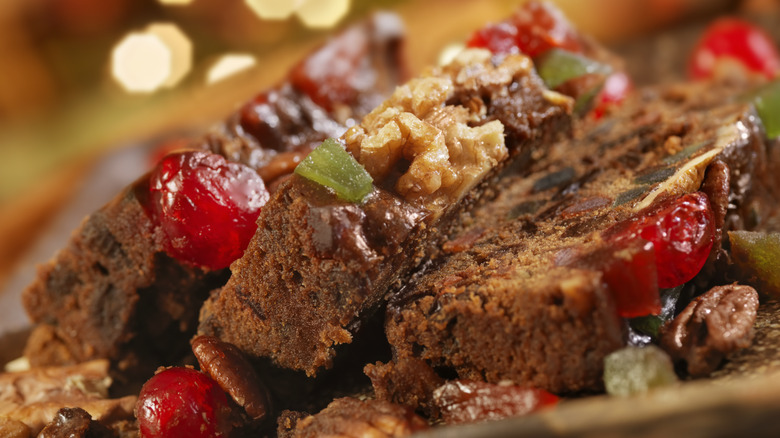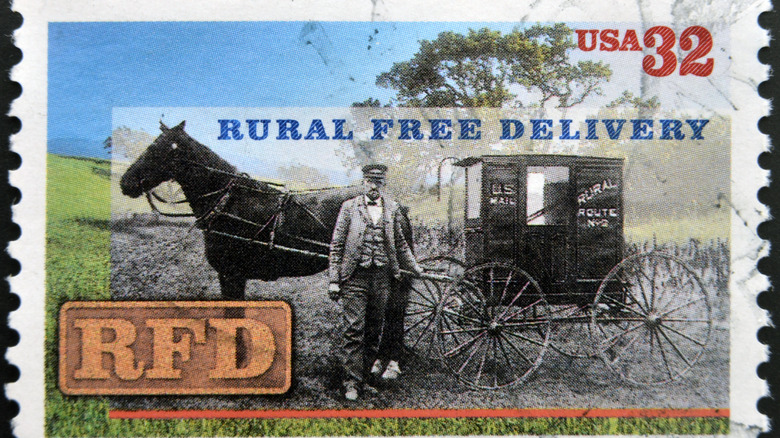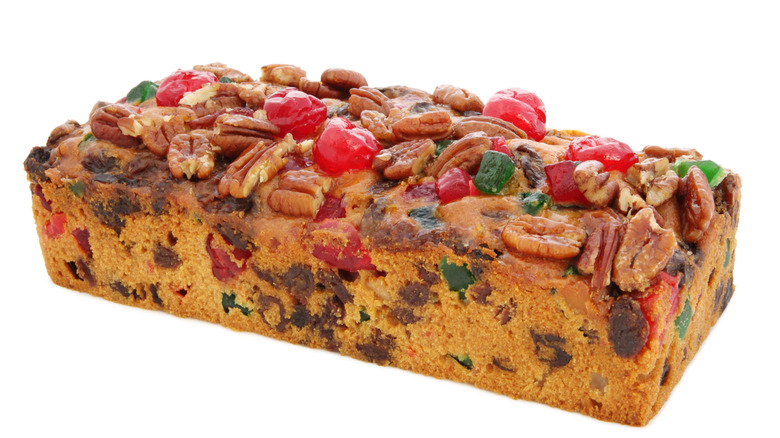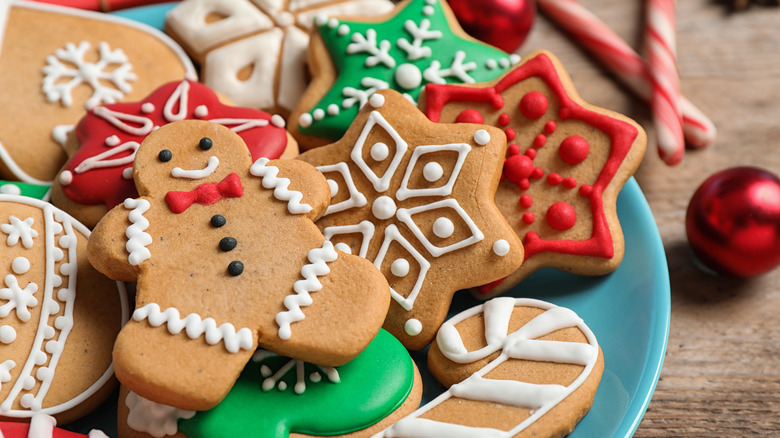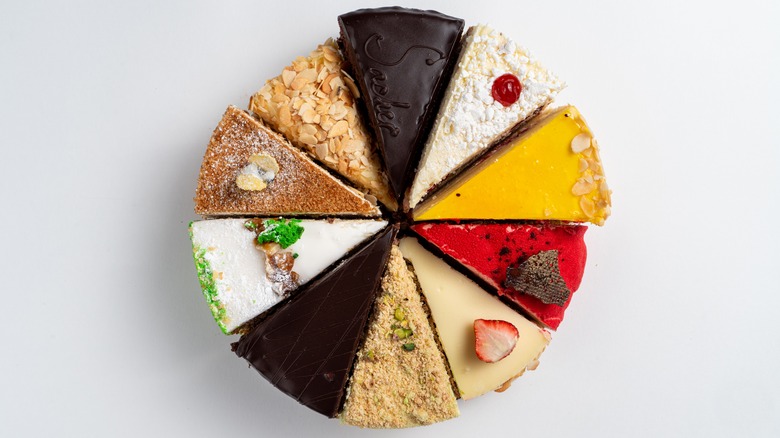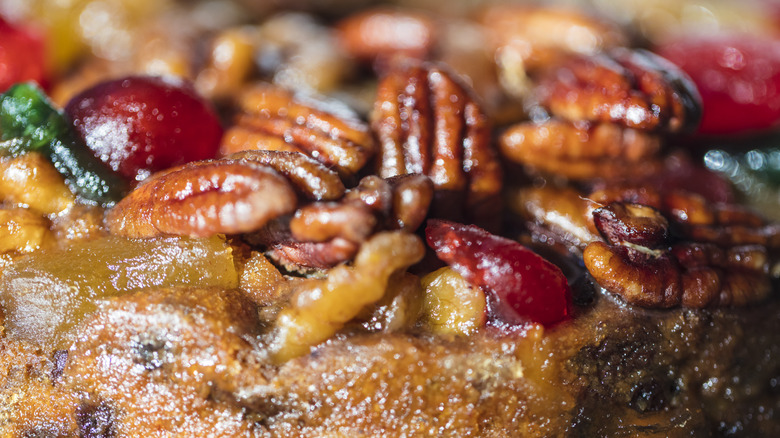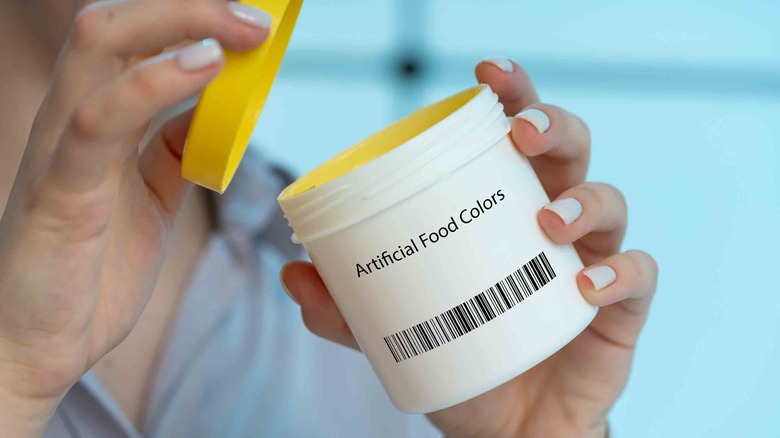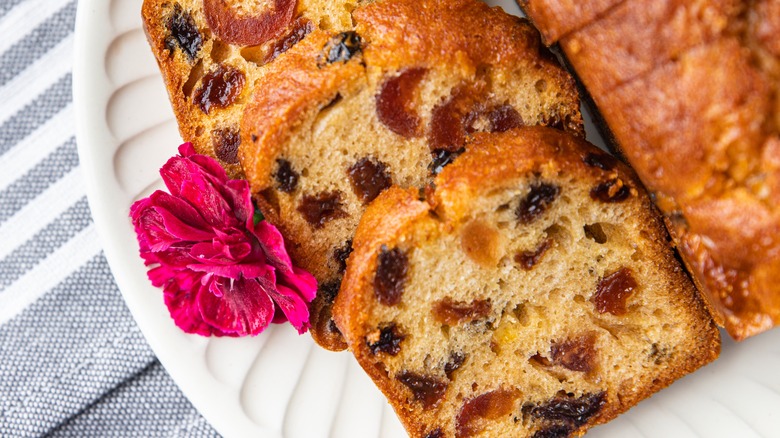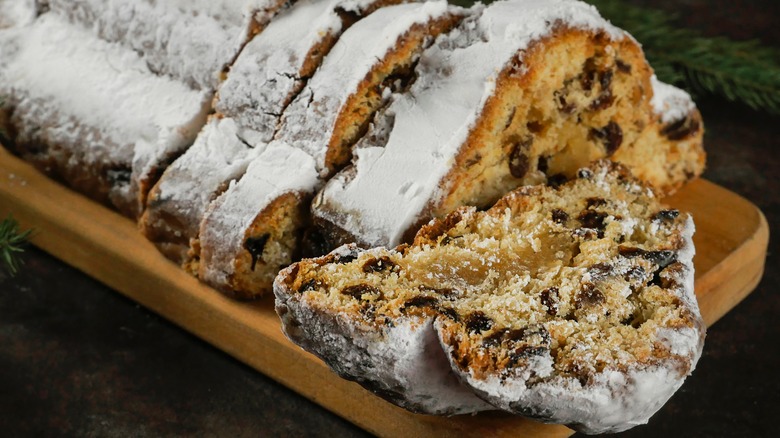Why Fruitcake Isn't As Popular Today As It Once Was
Fruitcake is a classic holiday cake with a long and storied history. The first fruitcakes were left in tombs in Ancient Egypt to accompany royals into the afterlife, and the ancient Romans also had a version called satura. The cake developed and eventually arrived in the United States in the 1600s, but it didn't reach its full popularity until the turn of the 20th century. Since then, this extremely shelf-stable cake has seen a rise and fall in popularity. It's the butt of many jokes and yet still finds itself on holiday tables.
That said, fruitcake is no longer in its heyday. But ... why? From reasons varying from financial to health to changing tastes, people in the United States don't like this holiday classic the way they used to. Keep reading to learn exactly when and why fruitcake fell from grace and find out what people are eating instead.
When was fruitcake popular?
Fruitcake owes its initial popularity in the U.S. to the rise of mail order. The Rural Free Delivery and Parcel Post services began operations at the end of the 19th and 20th centuries, respectively. Thanks to the amount of alcohol in it, fruitcake has a long shelf-life, making it a great shipping candidate. That was especially convenient in an era of pre-refrigeration. (Just how long does fruitcake last? One baked in 1878 is still in circulation!) Two of the most well-known fruitcake companies today — Claxton and Collin Street — got their starts back then.
Fruitcake was still a very important holiday tradition, even in the 1950s. Per Forbes, a 1952 article published in the "Los Angeles Times" claimed, "Some like them dark. Some like them light. But everybody likes fruitcake!" The following year, the paper released a story featuring multiple fruitcake recipes. So, there was a point in the not-so-distant past when fruitcake was a cherished part of the holiday table and a welcome gift to receive.
When was its downfall?
It's hard to pinpoint precisely when fruitcake began its fall from grace. However, in 1989, Mastercard surveyed people about their least favorite holiday gifts, and a whopping 75% selected fruitcake. But considering comedian Johnny Carson joked, "There is only one fruitcake in the entire world, and people keep sending it to each other," just four years before that survey, it's safe to say that fruitcake was passé by the 1980s (via PBS).
That doesn't mean people weren't making fun of it earlier, though. In 2020, two friends from New York shared that they'd been exchanging the same fruitcake back and forth for about 50 years. They say the prank has brought them much joy over the years. There is no shortage of fruitcake-related comedy and commentary; there are countless quotes, phrases, and funny things said about fruitcake. Some anti-fruitcake articles go back to the 1990s, nearly as far back as internet publications themselves.
Why did fruitcake fall from grace?
Of course, knowing when fruitcake lost its popularity isn't the same as knowing why. While there are many versions of fruitcake around the globe, the U.S. American one has shifted over the years. When the dessert first arrived in the U.S. in the 17th century, it was made with natural ingredients, like dried fruits, nuts, and spices. However, the mass-produced fruitcakes that began to take over the industry with the advent of mail-order did not resemble true fruitcakes. They were dry, crusty, and filled with neon red and green candied cherries. In short, they didn't taste homemade.
For example, a Collin Street Bakery Deluxe Fruitcake contains: "Pecans, cherries (cherries, corn syrup, high fructose corn syrup, water, citric acid, natural and artificial flavor, potassium sorbate and sodium benzoate as preservatives, FD&C red #40 and sulfur dioxide (preservative)), pineapple (pineapple, cane sugar, citric acid as acidulant, sodium and potassium sorbate as preservatives, blue #1, red #40), wheat flour, raisins, sugar, margarine (liquid and hydrogenated soybean oil, water, salt), papaya (papaya, sugar, citric acid as acidulant, sodium benzoate and potassium sorbate as preservatives), water, honey, less than 2% of eggs, orange peel (orange peel, sugar, glucose-fructose, and citric acid)." Compare that to a recipe for a homemade fruitcake, which calls for flour, butter, brown sugar, eggs, rum, dried fruits, pecans, citrus zest, orange juice, and spices.
People have a lot of cookies instead
People are definitely still eating desserts during the holidays, so what are they having instead? One of the biggest treats to replace fruitcake is a batch of cookies — especially if Santa is visiting. The tradition of leaving cookies and milk for Santa Claus on Christmas Eve actually started during the Great Depression. Parents were attempting to teach their kids to be thankful for what they had, even in a time when they had very little.
But that doesn't mean all cookies are favored equally. A 2020 YouGov poll found there were some clear winners for the 1,300 people surveyed. The top five Christmas cookies are chocolate chip, sugar, fudge, brookies, and double chocolate. And the bottom five? Meringue, spritz, pfefferneuse, chai sugar, and anise. It seems that (at least of the people polled) U.S. tastes run sweet and not spicy. That could be another factor in the demise of the fruitcake.
Tastes are now more varied
Cookies aren't the only treat that has usurped fruitcake's popularity. There may be a shift in the U.S. palate toward sweet treats, but that doesn't mean people's favorite desserts are all the same. According to a 2019 survey by OnePoll, more than half the country looks forward to a yearly traditional dessert, and nearly 80% say the holidays wouldn't be the same without it (via SWNS Media).
Meanwhile, a 2020 Zippia article analyzed Google search trends to determine which holiday desserts were trending in each state. Cheesecake and peppermint-flavored desserts were some of the top contenders. Nine states had cheesecake as the highest search term, whereas Pennsylvanians specified gingerbread cheesecake, and Hawaiians Googled Oreo cheesecake.
In one, perhaps surprising, twist, Missouri had more searches for "vegan Christmas cookies" than the rest of the country. Other popular sweets included cake, candy, cookies, hot chocolate, and eggnog. However, fruitcake isn't entirely out of the U.S. population's consciousness. Both North and South Carolina searched for it more than any other dessert.
Fruitcake is expensive
It's no secret that food costs are on the rise. Processed and manufactured foods are increasingly expensive, and if you want to make a traditional fruitcake, you'll need to use many ingredients, some of which are higher-end items. This has negatively affected small businesses, which have had to raise their prices. Large-scale bakeries also have prices that may exceed the average person's spending range.
A 1-pound fruitcake from purveyor Harry & David will run you $24.99 as of December 2023. Global News Canada reports that in 2023, making homemade fruitcake can cost roughly $50 a pound due to supply chain issues affecting the cost of ingredients. While food prices in Canada are currently more expensive than in the U.S., stateside we have also seen significant inflation, from food costs to basic utilities like gas and electricity.
Interestingly, this is not the first time fruitcake has suddenly become more expensive. In 1978, the cost of making homemade fruitcake in Canada was 50% higher than the previous year. Due to inflation, the cost of ingredients was increasing daily. In October of 1978, making a fruitcake would have cost a consumer CAD 15.08 and, just one month later, CAD 18.23. While we couldn't find specific fruitcake-related stats for the '70s in the U.S., inflation between 1970 to 1981 was close to 8% each year. Could this late-70s inflation have led to the universal panning of the cake in the 1980s?
It's not that healthy
Like many desserts with the word "fruit" in them, fruitcake isn't healthy by any means. Depending on the brand, one slice can contain as many as 500 calories, 21 grams of fat, and 48 grams of sugar. (But it's the holidays, so we aren't judging if that's your indulgence.) If you are preoccupied about calories, you could consider using yogurt instead of butter to reduce the fat and calories in your homemade recipe.
Besides the nutrition facts, there's always the worry about food dye. The bright green and red fruit of commercial fruitcake contains a lot of food dye. Food dyes may or may not be hazardous, so taking a tempered approach to your worry is a good idea. Most commercial food dyes are synthetic compounds used to color food artificially. Though people have been coloring food for centuries, the first artificial dyes came out in 1856 and were made from coal tar. Today, most are made with petroleum. Different countries have different regulations about dyes; the U.S. Food and Drug Administration and the European Food Safety Authority approve the use of six dyes for human consumption, including Red 40, Yellow 5, and Yellow 6.
But wait, is fruitcake really unpopular?
Before we nail the coffin on fruitcake, it's important to look at the actual numbers. The dessert is indeed snubbed publicly, and no, it is not as popular as it once was. However, people in the United States still buy a few million fruitcakes each year. According to Collin Street Bakery, which opened in the 1890s, the company pulled in $20 million in sales in 2020, and sold 1.5 million cakes the previous year. But Collin Street Bakery isn't the only successful purveyor of fruitcakes. That same year, two bakeries in Claxton, Georgia, sold 4 million cakes, and Harry and David shipped out 100,000.
Further, in 2017, Adweek reported that fruitcake witnessed a "resurgence." Chief among those more interested in the dessert were younger people. This could be in part due to Gen Z's and Millennial's fondness for nostalgia. What's more nostalgic than the same cake you've seen on your holiday table year after year?
And around the world, it's still going strong
U.S.-style fruitcake isn't the only kind out there. From Bajan black cake to German stollen to U.K. royal wedding cakes, fruitcake hasn't lost its popularity elsewhere — nor is it hotly debated. Some versions are considered among the best Christmas cakes around the world.
Take panettone, for example. The way you serve this centuries-old Italian bread is relatively simple — a slice with coffee for breakfast. Another version of European fruitcake is stollen, a German Christmas bread studded with fruit and often stuffed with marzipan. Bajan black cake's ingredients aren't dissimilar from a fruitcake in the U.S. However, this cake is always soaked in rum and usually topped with Falernum, an alcoholic syrup. British fruitcakes are also similar but are typically covered with marzipan.
While fruitcakes may not be as popular as they once were, they still have their fans around the world.
